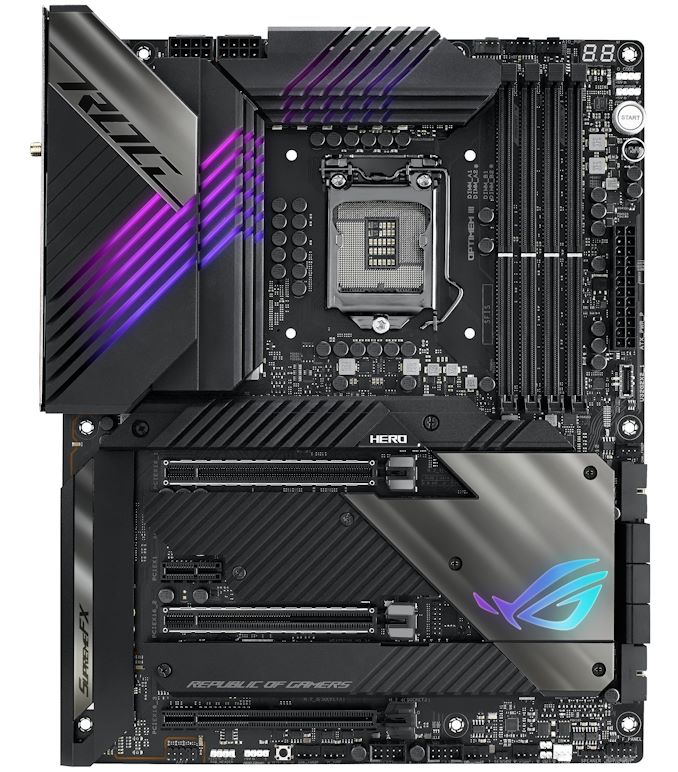The Intel Z590 Motherboard Overview: 50+ Motherboards Detailed
by Gavin Bonshor on January 19, 2021 10:15 AM ESTASUS ROG Maximus XIII Hero
Another model from ASUS's ROG Maximus line-up is the highly favorable Hero. The ROG Maximus XIII Hero offers Wi-Fi 6E, with dual 2.5 GbE and four PCIe M.2 slots. It uses a slightly different aesthetic compared with the previous Z490 Hero, with RGB LED lighting built into the rear panel cover and chipset heatsink. Still, ASUS's illustration leaves the question open whether or not the power delivery heatsink has them integrated too, which seems unlikely. The new Hero uses an ATX PCB, with a 14+2 power delivery with 90 A teamed power stages. Powering the CPU is a pair of 12 V ATX CPU power inputs.
The ASUS ROG Maximus XIII Hero includes a nice black and dark gray contrasting design, with three full-length PCIe slots. The top two operate at PCIe 4.0 x16 and x8/x8, while the bottom full-length slot is locked to PCIe 3.0 x4, and there is also one PCIe 3.0 x1 slot. The Hero includes six SATA ports with support for RAID 0, 1, 5, and 10 arrays, with four PCIe M.2 slots. Two of the M.2 slots operate at PCIe 4.0 x4, while the other two can support PCIe 3.0 x4 and SATA drives. In the top right-hand corner are four memory slots with support for up DDR4-5333, with a combined capacity of 128 GB. In the top right-hand corner of the board is a two-digit LED debugger, with a power on and rest switch pairing just below it.
On the rear panel is two Thunderbolt 4 Type-C, with six USB 3.2 G2 Type-A and two USB 2.0 ports. ASUS includes two RJ45 ports powered by two Intel I225-V 2.5 GbE controllers, with an Intel AX210 Wi-Fi 6E CNVi, which also includes support for BT 5.2 devices. For users planning to use Intel's integrated graphics, ASUS includes one HDMI video output. Regarding audio, ASUS is using a SupremeFX ALC404082 HD audio codec, with an ESS Sabre9018Q2C DAC. Finishing off the rear panel is a clear CMOS button and a BIOS Flashback button with a highlighted USB 2.0 port, which users can use to flash the board's firmware.
Typically bridging the gap between the ROG Maximus Extreme and Formula models to the Strix series, ASUS has set a price of $500. While this does seem on the high side of Z590 pricing, which we already know, ASUS does include a stacked rear panel including dual Thunderbolt 4 Type-C, dual 2.5 GbE, Wi-Fi 6E, as well as six USB 3.2 G2 Type-A.












88 Comments
View All Comments
Oxford Guy - Tuesday, January 19, 2021 - link
You’ll never be able to block all the spyware with a firewall. Windows is just one component of it. Don’t forget things like stealth CPUs that are built into the CPU, like the little friend on Lando’s shoulder. Etc.lmcd - Tuesday, January 19, 2021 - link
What, the tinfoil hat isn't enough anymore? The "spyware" is just as present on any Windows era.If you want to disable built in telemetry, pay for pro and disable it in the registry. It's not hard if you're really that into privacy.
Spunjji - Wednesday, January 20, 2021 - link
@lmcd - but that would require *effort* - why waste that effort on customising a modern OS, when he could expend more effort cobbling together a barely-working platform on a 12-year-old one? 😂Makaveli - Wednesday, January 20, 2021 - link
lol all I saw in my head reading those post are "old man yells at clouds"Oxford Guy - Friday, January 22, 2021 - link
That’s due to the fact that the old man has just as much chance of getting the spyware out of Windows and CPUs (and the rest) as you lot have a chance of saying something relevant.Oxford Guy - Friday, January 22, 2021 - link
Call us when the shuttle lands, Pauline.Slash3 - Tuesday, January 19, 2021 - link
Z590 only provides six native SATA ports.ASRock's Z590 Taichi has eight ports, with two via an ASMedia ASM1061 controller.
Silver5urfer - Wednesday, January 20, 2021 - link
Got it thanks. I suppose that's how the EVGA Dark got it's 8 SATA ports too.weilin - Thursday, April 29, 2021 - link
Z590, if i remember correctly... has 30 HSIO lanes total:6 of which are dedicated to USB (and can be ganged in pairs for 20Gb/s ports)
4 more that is either USB 10Gb/s or 5Gb/s or PCIe.
2 of them which can be Ethernet or PCIe,
2 of them which can be SATA, Ethernet, or PCIe.
6 of them which can be SATA or PCIe.
10 dedicated PCIe
So everything all together means theoretically maximum of:
4 LAN ports
8 SATA ports
10 USB ports
24 PCIe ports
It's up to motherboard manufacturers to configure them as they see fit. It seems like the popular choice is to maximize USB, leave SATA at 6 and put the rest on PCIe ports (take 1 or 2 away for Ethernet, and 4 away for Thunderbolt if present).
weilin - Thursday, April 29, 2021 - link
If anyone's interested in see the doc:https://ark.intel.com/content/www/us/en/ark/produc...
On to left its under "Technical Documentation" -> "Intel® 500 Series Chipset Family Platform Controller Hub Datasheet, Volume 1 of 2" -> bottom of page 18